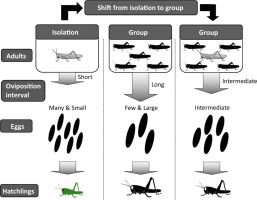当前位置:
X-MOL 学术
›
J. Insect Physiol.
›
论文详情
Our official English website, www.x-mol.net, welcomes your feedback! (Note: you will need to create a separate account there.)
The desert locust, Schistocerca gregaria, plastically manipulates egg size by regulating both egg numbers and production rate according to population density.
Journal of Insect Physiology ( IF 2.2 ) Pub Date : 2020-02-06 , DOI: 10.1016/j.jinsphys.2020.104020 Koutaro Ould Maeno 1 , Cyril Piou 2 , Saïd Ghaout 3
Journal of Insect Physiology ( IF 2.2 ) Pub Date : 2020-02-06 , DOI: 10.1016/j.jinsphys.2020.104020 Koutaro Ould Maeno 1 , Cyril Piou 2 , Saïd Ghaout 3
Affiliation

|
Egg-size adjustment is one of the important plastic life-history traits for animals living in heterogeneous environments. The adaptive investment hypothesis predicts that mothers should increase progeny size according to certain cues predicting adverse future conditions of their offspring. However, reproductive resources are limited, and females have to simultaneously reduce egg number to allocate more resources to increase size. It remains unclear how single individuals alter egg size and number according to temporally heterogeneous environments. In the present study, we examined how desert locusts, Schistocerca gregaria, plastically alter egg size and number according to population density. We also investigated the trans-generational maternal effects on progeny characteristics as well as their own maternal physiological response (oviposition interval). Females kept in crowded conditions laid significantly larger and heavier eggs by reducing clutch size (number of eggs per egg pod) compared to isolated females, suggesting the existence of a reproductive trade-off between the two traits. The crowding-forced isolated females induced concerted changes not only in egg size but also in egg number tending towards those characteristics of gregarious control, implying that single individuals showed trade-off when egg size was increased. Double-blind testing confirmed the rapid crowding effects on egg size. Females also responded to crowding by extending the oviposition interval. As the oviposition interval extended, egg size increased, but clutch size decreased. Eggs from crowding-forced isolated females began to produce gregarious-phase type hatchlings (large and black) instead of solitarious-phase type ones (small and green). These results suggested that S. gregaria plastically manipulate egg size by regulating egg numbers and egg production rate, and indicated the presence of trans-generational maternal effects on progeny phase.
中文翻译:

沙漠蝗虫日本血吸虫(Schistocerca gregaria)通过根据种群密度调节卵的数量和生产率来操纵卵的大小。
蛋大小调节是生活在异质环境中的动物重要的可塑性生活史特征之一。适应性投资假说预测,母亲应根据某些预测其后代不利状况的线索来增加子代大小。但是,生殖资源有限,雌性必须同时减少卵数以分配更多资源以增加体型。尚不清楚单个个体如何根据时间异质环境改变卵的大小和数量。在本研究中,我们研究了沙漠蝗虫,日本血吸虫(Schistocerca gregaria)如何根据种群密度可塑性改变卵的大小和数量。我们还研究了跨代母体对子代特征的影响以及它们自身的母体生理反应(产卵间隔)。与孤立的雌性相比,处于拥挤条件下的雌性通过减少离体大小(每个卵荚中的卵数)而产下更大,更重的卵,这表明这两个性状之间存在繁殖权衡。受挤迫的孤立雌性不仅引起卵大小协调一致的变化,而且趋向于以群居控制为特征的卵数目一致变化,这意味着当卵大小增加时,单个个体表现出权衡。双盲测试证实了对鸡蛋大小的快速拥挤效应。女性也通过延长排卵间隔来应对拥挤。随着产卵间隔的延长,卵的大小增加,但离合器尺寸减小。来自被挤迫的孤立雌性的卵开始产生群相型孵化(大和黑色),而不是单相型孵化(小和绿色)。这些结果表明,紫花链球菌通过调节卵的数量和产卵率来可塑性地调节卵的大小,并表明存在后代母体对子代期的影响。
更新日期:2020-03-20
中文翻译:

沙漠蝗虫日本血吸虫(Schistocerca gregaria)通过根据种群密度调节卵的数量和生产率来操纵卵的大小。
蛋大小调节是生活在异质环境中的动物重要的可塑性生活史特征之一。适应性投资假说预测,母亲应根据某些预测其后代不利状况的线索来增加子代大小。但是,生殖资源有限,雌性必须同时减少卵数以分配更多资源以增加体型。尚不清楚单个个体如何根据时间异质环境改变卵的大小和数量。在本研究中,我们研究了沙漠蝗虫,日本血吸虫(Schistocerca gregaria)如何根据种群密度可塑性改变卵的大小和数量。我们还研究了跨代母体对子代特征的影响以及它们自身的母体生理反应(产卵间隔)。与孤立的雌性相比,处于拥挤条件下的雌性通过减少离体大小(每个卵荚中的卵数)而产下更大,更重的卵,这表明这两个性状之间存在繁殖权衡。受挤迫的孤立雌性不仅引起卵大小协调一致的变化,而且趋向于以群居控制为特征的卵数目一致变化,这意味着当卵大小增加时,单个个体表现出权衡。双盲测试证实了对鸡蛋大小的快速拥挤效应。女性也通过延长排卵间隔来应对拥挤。随着产卵间隔的延长,卵的大小增加,但离合器尺寸减小。来自被挤迫的孤立雌性的卵开始产生群相型孵化(大和黑色),而不是单相型孵化(小和绿色)。这些结果表明,紫花链球菌通过调节卵的数量和产卵率来可塑性地调节卵的大小,并表明存在后代母体对子代期的影响。


























 京公网安备 11010802027423号
京公网安备 11010802027423号